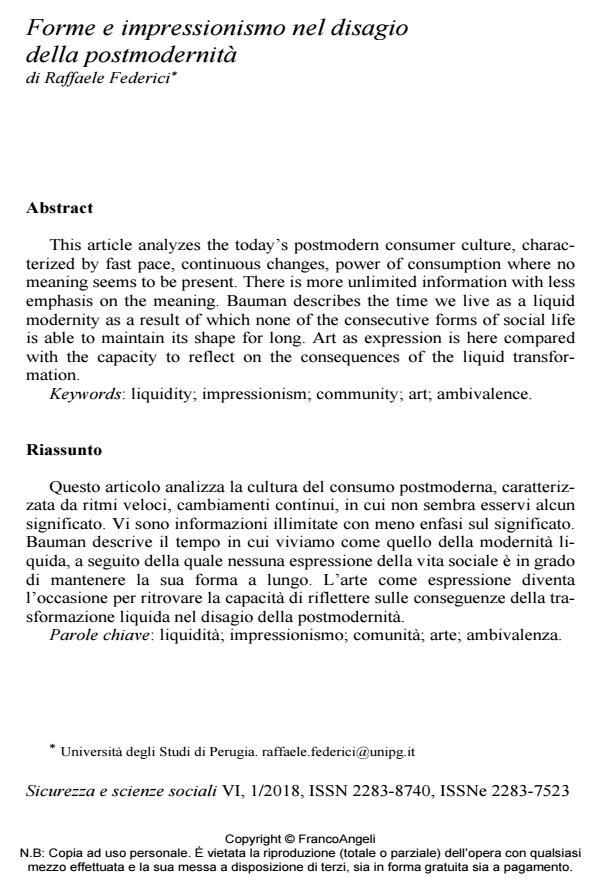Forme e impressionismo nel disagio della postmodernità
Journal title SICUREZZA E SCIENZE SOCIALI
Author/s Raffaele Federici
Publishing Year 2018 Issue 2018/1 Language Italian
Pages 10 P. 65-74 File size 225 KB
DOI 10.3280/SISS2018-001007
DOI is like a bar code for intellectual property: to have more infomation
click here
Below, you can see the article first page
If you want to buy this article in PDF format, you can do it, following the instructions to buy download credits

FrancoAngeli is member of Publishers International Linking Association, Inc (PILA), a not-for-profit association which run the CrossRef service enabling links to and from online scholarly content.
This article analyzes the today’s postmodern consumer culture, characterized by fast pace, continuous changes, power of consumption where no meaning seems to be present. There is more unlimited information with less emphasis on the meaning. Bauman describes the time we live as a liquid modernity as a result of which none of the consecutive forms of social life is able to maintain its shape for long. Art as expression is here compared with the capacity to reflect on the consequences of the liquid transformation.
Keywords: Liquidity; impressionism; community; art; ambivalence
- Arendt H. (1977). Between Past and Future. Harmondsworth: Penguin.
- Abensour M. (2012). Della compattezza. Architetture e totalitarismi. Milano: Jaca Book.
- Bachelard G. (1970/1975). Introduzione alla Bibbia di Chagall. In: Id. Il diritto di sognare. Bari: Dedalo.
- Barr A.H. Jr. (1958). The New American painting = La nuova pittura Americana. Milano: Silvana Editoriale.
- Baumgarten J. (1900). Le Yiddish. Paris: Presses Universitaires de France.
- Bauman Z. (1999). Da pellegrino a turista. In: Id. La società dell’incertezza. Bolo-gna: il Mulino.
- Bauman Z. (2001). Voglia di comunità. Roma-Bari: Laterza.
- Bauman Z. (2002a). Modernità liquida. Bari-Roma: Laterza.
- Bauman Z. (2002b). Il disagio della postmodernità. Milano: Bruno Mondadori.
- Bauman Z. (2005a). La sociologia dopo l’Olocausto. In: Beilharz P., a cura di, Globalizzazione e Glocalizzazione. Roma: Armando.
- Bauman Z. (2005b). Vite di scarto. Bari-Roma: Laterza.
- Bauman Z. (2007). Liquid Arts. Theory, Culture and Society, 24, 1: 117-126.
- Bauman Z. (2010). Modernità e ambivalenza. Torino: Bollati Boringhieri.
- Bauman Z. (2011). L’arte della vita. Bari-Roma: Laterza.
- Bauman Z., Tester K. (2002). Società, etica, politica. Conversazioni con Zygmunt Bauman. Milano: Raffaello Cortina.
- Bidussa D. (2014). Nella terra di nessuno. In: Bauman Z. Visti di uscita, biglietti di entrata. Firenze: Giuntina.
- Blumenberg H. (1984). La leggibilità del mondo. Bologna: Il Mulino.
- Calvino I. (1993). Le città invisibili. Milano: Mondadori.
- Camus A. (1992). Taccuini 1951-1959. Milano: Bompiani.
- Celant G., Pistoletto M. (1984). Pistoletto. Firenze: Elekta.
- Chagall M. (1931). Ma vie. Paris: Stock.
- Chesneau E. (1874). À côté du Salon, Le plein air, Exposition du boulevard des Capucines. Paris-Journal, 7 Mai 1874.
- De Kooning W. (1963). Content is a glimpse. Interview with David Sylvester. In: Stiles K. e Selz P., a cura di, Berkley: University of California Press.
- Dorfles G. (1961), Ultime tendenze nell’arte di oggi. Dall’informale al postmoderno. Milano: Feltrinelli.
- Eco U. (1972). Estetica e teoria dell’informazione. Milano: Bompiani.
- Grosz G. (1923). Ecce Homo. Berlin: Malik Verlag.
- Han B.C. (2017). Il profumo del tempo. L’arte di indugiare sulle cose. Milano: Vita & Pensiero.
- Jankéelevitch V. (1998). Le pardon. In: Id. Philosophie morale. Paris: Flammarion.
- Kundera M. (1988). L’arte del romanzo. Milano: Adelphi.
- Meyer F. (1995). Marc Chagall. Paris: Flammarion.
- Nietzsche F.W. (2001). Così parlò Zarathustra. Un libro per tutti e per nessuno. Milano: Mondadori.
- Pistoletto M. (2013). Ripartire dalla grazia. In: Trione V. Postclassici. La ripresa dell’antico nell’arte contemporanea italiana. Milano: Skira.
- Richter F. (1924). Der Begriff des Lebens in der Philosophie Georg Simmels. Phil. Diss: Gießen.
Raffaele Federici, Forme e impressionismo nel disagio della postmodernità in "SICUREZZA E SCIENZE SOCIALI" 1/2018, pp 65-74, DOI: 10.3280/SISS2018-001007